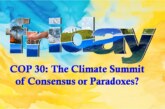
Dr. Arvind Kumar*
At the midway point of Agenda 2030, the outlook is grim: only 17% of targets are progressing as planned. While there’s steady improvement in access to electricity, internet, and child healthcare, critical areas like press freedom, corruption control, and sustainable nitrogen use are regressing. Europe, led by Finland, Sweden, and Denmark, continues to dominate the SDG Index, yet even these frontrunners face hurdles on climate and biodiversity goals. In contrast, East and South Asia have shown the fastest progress since 2015, driven by gains in socioeconomic targets. For the first time, India ranks 99th out of 193 countries, breaking into the top 100. It’s a symbolic climb reflecting both meaningful strides and stubborn gaps. Still, over half the world’s population lives in countries constrained by debt and limited fiscal space, unable to invest adequately in sustainable development. Meanwhile, global commitment remains high, with 190 UN member states presenting national SDG plans, and a surge in Voluntary Local Reviews (VLRs). Yet, the disconnect between ambition and action is growing, making this a crucial inflection point. The bottom line? The decade of delivery is slipping into a decade of delay.
With the Sustainable Development Report 2025 delivering a sobering reality check, the million-dollar question persists: Are we racing toward sustainability—or dragging ourselves forward, shackled by statistics?
Is the world truly sprinting toward sustainability—or merely limping along, burdened by metrics?
India’s 2025 SDG trajectory is a compelling paradox an ascent laced with asymmetries. It now outpaces Bangladesh (114th) and Pakistan (140th), though it still lags behind Bhutan, Nepal, and the Maldives. The momentum is undeniable, but so are the structural undercurrents pulling it back. There’s cause for cautious optimism. Universal electrification (99.2%), an expanding renewables portfolio, and a steep drop in extreme poverty (1.1%) underscore real progress. The country’s digital public infrastructure boom with over 55% internet penetration and mobile broadband subscriptions crossing 60 per 100 has become a cornerstone of inclusive growth. Yet, the cracks run deep.
Decoding India’s SDG journey
The climate crisis, meanwhile, is no longer a forecast it’s a lived condition. 2024 was India’s hottest year on record, marred by erratic monsoons, heatwaves, and inundating floods. Water stress is escalating, aggravated by aquifer depletion and river disputes. The Jal Jeevan Mission has extended piped access to 93.3%, but basic sanitation still lags at 78.4%, and only 19.2% of wastewater is treated, leaving the rest to seep into rivers and aquifers. The fallout cascades across health (SDG 3), gender equity (SDG 5), and urban resilience (SDG 11).
India’s material metabolism is ballooning. With a low circularity index, 2.9 kg per capita of unrecycled e-waste, and rising municipal solid waste, the country faces a mounting ecological tab. The LiFE Mission and EPR frameworks are commendable but insufficient. Production-based nitrogen emissions at 22.1 kg per capita, swelling household consumption, CO₂ emissions (2.2 tCO₂ per capita) and GHG trajectory remain on an upward slope, challenging net-zero commitments. Climate action (SDG 13) now bleeds into food security (SDG 2), infrastructure (SDG 9), and energy equity (SDG 7). It demands not tweaks, but a tectonic shift in policy and public behaviour.
And then there’s the coastline, choking under the weight of marine pollution. With a dismal Clean Waters score of 32.3 and only 4.2% of key marine biodiversity sites protected, the degradation is not just environmental—it’s existential. Overfished waters (7.4% from collapsed stocks) imperil livelihoods and nutrition alike. While Swachh Sagar Abhiyan and India’s assertiveness in High Seas Treaty talks signal intent, the response must now scale from sporadic to systemic.
Let’s zoom out for a moment and look at the big picture—the “transversality approach.” Progress in water (SDG 6), oceans (SDG 14), climate (SDG 13), and responsible consumption (SDG 12) isn’t just about ticking boxes on an international checklist. These four goals form the ecological bedrock, the “ecological ceiling” of sustainable development.
If we breach these boundaries by overdrawing groundwater, polluting oceans, destabilizing the climate, or overconsuming resources every other SDG becomes collateral damage. Health outcomes (SDG 3) deteriorate, food security (SDG 2) is jeopardized, gender equity (SDG 5) stalls, and economic growth (SDG 8) becomes unsustainable. Conversely, progress in these foundational SDGs acts as a force multiplier, unlocking cascading benefits across the entire 2030 Agenda.
Therefore, as we look beyond 2030, the SDGs must remain our global compass. For India and the world, the time has come to move from fragmented compliance to systemic commitment. Water security must lead the charge; not as an isolated goal but through a transversality approach, that recognizes its cross-cutting impact on health, food, gender, and climate. Integrated water resources management, particularly through basin-wise planning and wetland-wise governance, powered by AI and IoT for real-time monitoring, is essential for resilience in climate-vulnerable and ecologically sensitive regions. These hydrological units must become the core units of policy execution, not afterthoughts. The circular economy must graduate from the side-lines. Waste should be treated as economic value, not burden. Scaling up EPR, incentivizing green procurement, and embedding urban mining into policy can mainstream circularity.
Way Forward
India’s climate strategy needs recalibration; adaptation must take center stage alongside mitigation. Climate-resilient infrastructure, decentralized renewables, and innovative finance like green bonds can bridge ambition with action. Coastal protection, too, demands urgent elevation. From a marine biodiversity index to blue carbon incentives and community-led governance, the ocean economy must be both ecological and equitable. Yet, none of these ambitions can be realized without the bedrock of strong institutions and dynamic partnerships. SDG 16 and SDG 17 are not peripheral, they are the very foundation upon which all other progress depends. Transparent governance, effective environmental tribunals, data-driven accountability, and timely justice are essential to turn policy into practice. Decentralized SDG monitoring and sesnsitive budgeting at the state and district level will ensure that solutions are tailored and outcomes are measurable. Above all, forging alliances across government, business, academia, and civil society must become the rule, not the exception.
The 2025 SDR is a wake-up call. We are off track but not out of time. What is needed now is leadership, urgency, and collaboration. Because sustainable development isn’t a checklist, it’s a civilizational imperative.
*Editor, Focus Global Reporter






